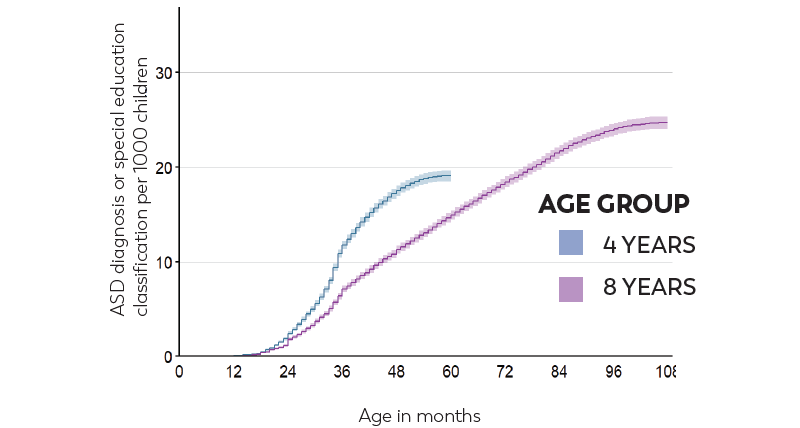Spotlight On Progress in Early Identification Disrupted during the COVID-19 Pandemic among 4-year-old Children
‹View Table of Contents
The ADDM Network found evidence of progress in early identification among children born in 2016 compared with children born in 2012, but evaluations and identification were disrupted after the onset of the COVID-19 pandemic.
More children are being
identified with ASD by 48 months


Key Findings from the ADDM Network
More children are being identified with ASD at an earlier age.
Overall, progress has been made in the early identification of ASD. In 2020, children born in 2016 (4-year-olds) were 1.6 times as likely as children born in 2012 (8-year-olds) to be identified as having ASD by 48 months of age. This is important because the earlier a child is identified with ASD, the earlier they can access services and support.
These patterns are consistent with previous reports and may indicate improvements in practices among families, healthcare providers, and educators to evaluate and identify children with ASD early.
COVID-19 disrupted progress in early ASD identification leading to a potential backlog of unidentified cases
Beginning around March 2020, children born in 2016 began to receive fewer evaluations and ASD identifications within ADDM Network communities compared to children born in 2012 during the same age window. Delays in evaluation could have long-lasting effects as a result of delays in identification and initiation of services during the COVID-19 pandemic.
Communities could benefit from evaluating the impact of these disruptions, children who may have experienced delays in evaluation and ASD identification, and considering strategies to lessen service disruptions and longer-term effects during public health emergencies in the future.
Tracking ASD among 4-year-old children
Understanding more about the characteristics of children with ASD, such as age of diagnosis and intellectual ability, helps us identify areas where progress has been made in early identification and areas where there are still opportunities for improvements.
- Developmental monitoring (also known as tracking or surveillance) is important for all children. Caregivers, such as parents, healthcare providers, and early educators, can learn how to look for developmental milestones—how children grow, move, communicate, interact, learn, and play. This information helps caregivers know what to expect at different ages, get ideas on how to promote positive development, and recognize potential concerns about development as early as possible. Developmental monitoring is an ongoing process, and CDC’s Learn the Signs. Act Early. program has tools and information to help at www.cdc.gov/ncbddd/actearly/index.html.
- A developmental screen is a short test using a validated screening tool to identify whether a child is learning basic skills that can help determine if there might be a delay. The American Academy of Pediatrics recommends screening children for ASD at 18 and 24 months of age.
- A comprehensive developmental evaluation is a thorough review of how a child plays, learns, communicates, acts, and moves, and whether those characteristics have changed over time. Various professionals can conduct developmental evaluations, including teachers, social workers, nurses, psychologists, doctors, physical therapists, and speech-language pathologists. This evaluation can include clinical observation, parental reports of developmental and health histories, psychological testing, and speech and language assessments. A comprehensive developmental evaluation is often a key step in getting services, including those through the school system.
- Diagnosis occurs when a developmental pediatrician, child neurologist, child psychiatrist, or child psychologist uses the results of the comprehensive developmental evaluation to determine whether a child has ASD. Neurological and genetic testing can often rule out other disorders and can check for genetic and neurological problems that sometimes occur along with ASD. A medical diagnosis can be a key step in getting medical services provided through health insurance.

Pages in this Report
- 2023 Community Report on Autism
- Executive Summary
- Key Findings from the ADDM Network
- A Deeper Dive
- ›Spotlight On: Progress in Early Identification Disrupted during the COVID-19 Pandemic
- Spotlight On: A New Pattern in Racial and Ethnic Differences
- Data for Action
- ADDM Network Site Snapshots Overview
- A Snapshot of Autism Spectrum Disorder in Arizona
- A Snapshot of Autism Spectrum Disorder in Arkansas
- A Snapshot of Autism Spectrum Disorder in California
- A Snapshot of Autism Spectrum Disorder in Georgia
- A Snapshot of Autism Spectrum Disorder in Maryland
- A Snapshot of Autism Spectrum Disorder in Minnesota
- A Snapshot of Autism Spectrum Disorder in Missouri
- A Snapshot of Autism Spectrum Disorder in New Jersey
- A Snapshot of Autism Spectrum Disorder in Tennessee
- A Snapshot of Autism Spectrum Disorder in Utah
- A Snapshot of Autism Spectrum Disorder in Wisconsin
- Glossary
- References